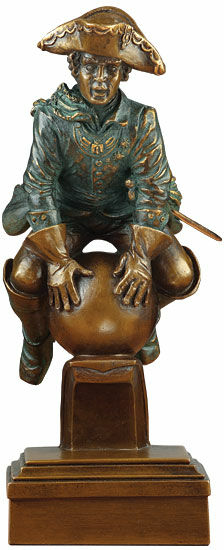Sculpture "Ride on the Cannonball", cast
Sculpture "Ride on the Cannonball", cast
Quick info
ars mundi Exclusive Edition | cast | handmade | bronzed | size 9 x 23.5 x 10.5 cm (w/h/d) | weight 1150 g
Detailed description
Sculpture "Ride on the Cannonball", cast
"Out of sheer courage and zeal for service, and a little hastily, I was standing before one of our largest cannon that was firing into the town. I waited till the word 'Fire' was given, then I sprang on to the cannonball intending to let it bear me inside the fortress, but when I was halfway there it occurred to me that I was acting very rashly. 'It is all very well,' thought I, 'to get inside the fortress, but how shall I get out afterwards? And what will happen to me in there?' I knew that if I were taken as a spy I should be hanged on the nearest gallows - an ignominious end for one who bore the proud name of Munchausen! As these thoughts passed through my mind, I perceived a bullet directed from the fortress against our camp passing a few feet from me. Without further hesitation, I leaped on it, and returned to our army, without, it is true, having accomplished my project, but at least safe and sound."
Hieronymus Carl Friedrich Freiherr von Münchhausen was born on his father's estate in Bodenwerder on 11 May 1720. After his education and a career as an officer in the service of Tsarina Catherine the Great, he returned in 1750 to steer the fortunes of his estate. Even during his lifetime, he was praised as a brilliant, humorous storyteller. Enjoying a bottle of alcohol with his friends, the "Baron of Munchhausen" used to tell stories of his travels and of wars in which he had taken part - wonderful stories and fun adventures on the sea and land. And, of course, he lied through his teeth...
Puss in Boots, Hans in Luck, Baron Munchhausen... Since our childhood, when we heard fairy tales and stories for the first time, each of us has carried a precise image of these figures in our minds. That is also the case for artists, including sculptors. They create a sculptural item of your version of these childhood companions on our behalf. We cast the filigree models of their childhood images in a complex process - these sculpture models are available exclusively from ars mundi.
Sculpture in polymer cast with bronzed surface. Size 9 x 23.5 x 10.5 cm (w/h/d). Weight 1150 g.
Customer reviews
Alles bestens, wie erwartet.
About Jochen Bauer
Born in 1951, sculptor and painter
The sculptor Jochen Bauer, born in 1951 in Coburg, Germany, was one of Germany's leading porcelain modellers for almost 30 years. From 1999 until today he has devoted himself to sculpture and painting as a freelance artist.
With his outstanding technique, he is regarded in the industry as one of the great talents whenever it comes to translating a concept into the third dimension. In his own work, he prefers naturalistic motifs, which he implements with perfect craftsmanship and a good eye for flowing (body-)shapes and expressive poses.
"The source of my creative activity is nature, the examination of ecological contexts..."
Graphic or sculpture edition that was initiated by ars mundi and is available only at ars mundi or at distribution partners licensed by ars mundi.
Collective term for all casting processes that ars mundi carries out with the help of specialised art foundries.
Stone casting
Similar to artificial marble, with the difference that the substitute stone in powder form is used instead of marble powder.
Bonded Bronze (Cold-Cast-Bronze)
Bronze powder is polymer-bonded. Special polishing and patination techniques give the surface of the casting an appearance similar to the bronze.
Imitation Wood
In order to guarantee absolute fidelity to the original, an artificially manufactured imitation wood is used as a base material that features typical wood characteristics: density, workability, colour and surface structure.
Ceramic Mould Casting
Ceramic mould casting usually requires the use of casting clay, which is then fired and optionally glazed. Instead of the usual rubber moulds, plaster moulds are often used in ceramic casting and porcelain production.
Cast Bronze (Lost-Wax Casting)
For the cast bronze, the thousand-year-old lost-wax technique is used. It's the best, but also the most complex method of producing sculptures.
A plastic work of sculptural art made of wood, stone, ivory, bronze or other metals.
While sculptures from wood, ivory or stone are made directly from the block of material, in bronze casting a working model is prepared at first. Usually, it is made of clay or other easily mouldable materials.
The prime time of sculpture after the Greek and Roman antiquity was the Renaissance. Impressionism gave a new impulse to the sculptural arts. Contemporary artists such as Jorg Immendorf, Andora, and Markus Lupertz also enriched sculptures with outstanding works.









